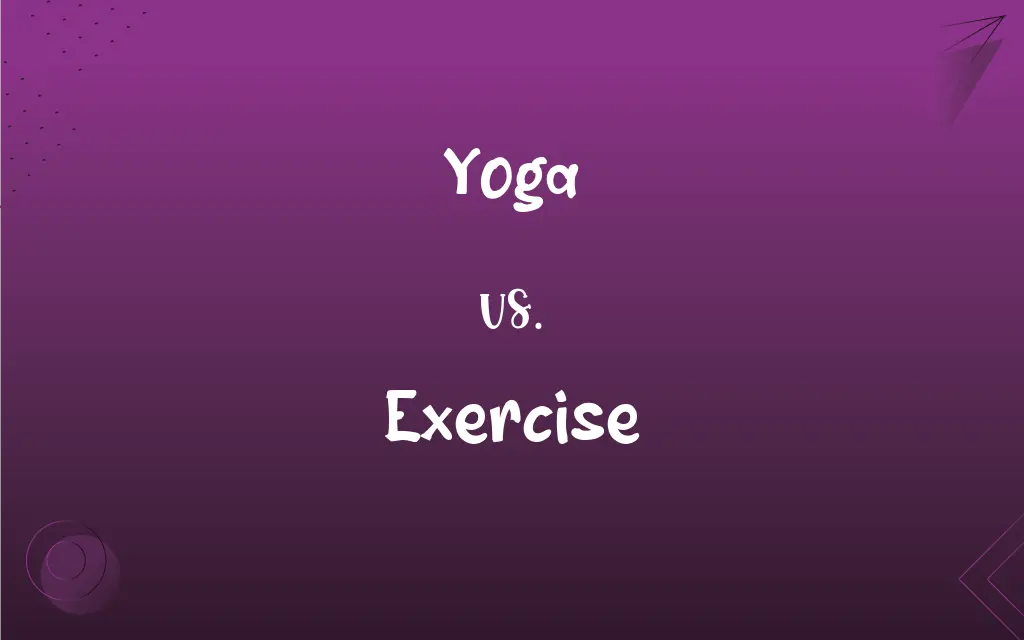Yoga vs. Exercise: What's the Difference?
Edited by Janet White || By Harlon Moss || Updated on October 26, 2023
Yoga is a holistic practice integrating mind, body, and spirit, while exercise focuses primarily on physical fitness and health.

Key Differences
Yoga is an ancient practice with origins in India, aiming to unify the mind, body, and spirit. It combines physical postures, breathing techniques, and meditation to enhance overall well-being. In contrast, exercise is a broad term referring to any activity that requires physical effort, meant to improve or maintain physical fitness and health. Exercise can include activities like running, swimming, or weightlifting.
While both yoga and exercise can improve physical health, yoga places a significant emphasis on mental and spiritual development. Through its various poses and breathing exercises, yoga aims to bring about a state of mindfulness, relaxation, and increased self-awareness. Exercise, on the other hand, primarily aims to increase cardiovascular endurance, muscle strength, and flexibility. It might not necessarily address the mental or spiritual aspects that yoga does.
Another distinguishing factor is the environment in which they are practiced. Yoga often encourages a calm, quiet environment, allowing individuals to focus inward, promoting self-reflection and tranquility. Exercise can be done in various settings, from a bustling gym to an open road, and is more oriented towards achieving specific physical goals or milestones.
In terms of benefits, both yoga and exercise offer numerous advantages for the body. Yoga can help in improving flexibility, balance, and muscle strength, and it's known to reduce stress, anxiety, and improve mental clarity. Exercise is vital for cardiovascular health, weight management, and building and toning muscles. However, it's worth noting that many people incorporate both yoga and exercise into their routines, recognizing the unique benefits each offers.
Comparison Chart
Primary Focus
Mind, body, and spirit unity
Physical fitness and health
ADVERTISEMENT
Origin
Ancient India
General term, no specific origin
Environment
Calm, quiet settings
Various, including gyms or outdoors
Benefits
Mental clarity, flexibility, balance
Cardio health, muscle strength
Involvement of Spirituality
Integral part
Typically not involved
Yoga and Exercise Definitions
Yoga
Yoga involves a combination of physical postures, breathing techniques, and meditation.
Through yoga, he found a deeper connection to his inner self.
ADVERTISEMENT
Exercise
Exercise is essential for weight management and muscle development.
Resistance training is his favorite form of exercise to build muscle.
Yoga
Yoga is an ancient discipline focusing on the unity of mind, body, and spirit.
She practices yoga daily to maintain her mental and physical balance.
Exercise
Regular exercise has been linked to numerous health benefits, including improved mood and increased lifespan.
His doctor advised him to start exercise to manage his blood pressure better.
Yoga
Yoga aims to promote self-awareness, relaxation, and mindfulness.
Attending a yoga retreat helped her disconnect from daily stresses and reconnect with her inner peace.
Exercise
Exercise is any physical activity aimed at improving or maintaining health and fitness.
She incorporated daily exercise into her routine to lose weight.
Yoga
Yoga is not just a physical practice but a lifestyle emphasizing holistic well-being.
He adopted the principles of yoga in his daily life, leading to a more contented existence.
Exercise
Exercise can include aerobic, anaerobic, flexibility, and balance activities.
Cardiovascular exercise, like running, helps improve heart health.
Yoga
Yoga is often practiced to reduce stress and enhance flexibility and strength.
Regular yoga sessions improved her posture and reduced her back pain.
Exercise
Exercise routines can vary in intensity from low-impact to high-intensity workouts.
She started with low-impact exercise and gradually moved to high-intensity interval training.
Yoga
Also Yoga An ascetic Hindu discipline involving controlled breathing, prescribed body positions, and meditation, with the goal of attaining a state of deep spiritual insight and tranquility.
Exercise
Activity that requires physical or mental exertion, especially when performed to develop or maintain fitness
Walks every day for exercise.
FAQs
What is the main purpose of yoga?
Yoga aims to unify the mind, body, and spirit.
How often should one engage in exercise?
Exercise frequency depends on individual goals, but a general recommendation is at least 150 minutes of moderate aerobic activity weekly.
Can yoga help with weight loss?
While yoga can support weight management, its primary focus is on overall well-being.
How does yoga differ from pilates?
While both emphasize posture and flexibility, yoga has a more spiritual focus, whereas pilates emphasizes core strength.
Are there any contraindications for practicing yoga?
Certain health conditions or injuries might limit specific yoga poses, so consulting a healthcare professional or trained yoga instructor is wise.
How does exercise benefit the muscles?
Exercise strengthens and tones muscles, improving their function and endurance.
Which exercise is best for heart health?
Aerobic exercises, like walking, running, and swimming, are beneficial for heart health.
Can exercise help with mental health?
Yes, regular exercise can boost mood and reduce anxiety and depression.
Can yoga improve flexibility?
Yes, consistent yoga practice can significantly improve flexibility.
Can yoga help with chronic pain?
Yes, certain yoga poses and techniques can alleviate chronic pain symptoms.
Should I consult a doctor before starting an exercise regimen?
Yes, especially if one has existing health issues or concerns, consulting a physician is advisable.
Can exercise aid in better sleep?
Yes, regular exercise can help improve sleep quality and duration.
Is yoga considered a form of exercise?
Yes, yoga involves physical postures and movements, making it a form of exercise.
Should I stretch before or after exercise?
It's recommended to do dynamic stretches before and static stretches after exercise.
What's the difference between aerobic and anaerobic exercise?
Aerobic involves longer, sustained activities using oxygen, while anaerobic involves short bursts of intense activity without relying on oxygen.
Is yoga suitable for all age groups?
Yes, yoga can be adapted for people of all ages, from children to seniors.
Do all yoga styles have a spiritual component?
Most yoga styles integrate a spiritual element, but the emphasis varies by style and teacher.
Can exercise boost immunity?
Moderate exercise can help strengthen the immune system, but excessive exercise may weaken it.
How can I avoid injuries during exercise?
Proper form, warming up, and not pushing beyond one's limits can help prevent injuries.
How is meditation related to yoga?
Meditation is a component of yoga, focusing on mindfulness and mental relaxation.
About Author
Written by
Harlon MossHarlon is a seasoned quality moderator and accomplished content writer for Difference Wiki. An alumnus of the prestigious University of California, he earned his degree in Computer Science. Leveraging his academic background, Harlon brings a meticulous and informed perspective to his work, ensuring content accuracy and excellence.
Edited by
Janet WhiteJanet White has been an esteemed writer and blogger for Difference Wiki. Holding a Master's degree in Science and Medical Journalism from the prestigious Boston University, she has consistently demonstrated her expertise and passion for her field. When she's not immersed in her work, Janet relishes her time exercising, delving into a good book, and cherishing moments with friends and family.































































